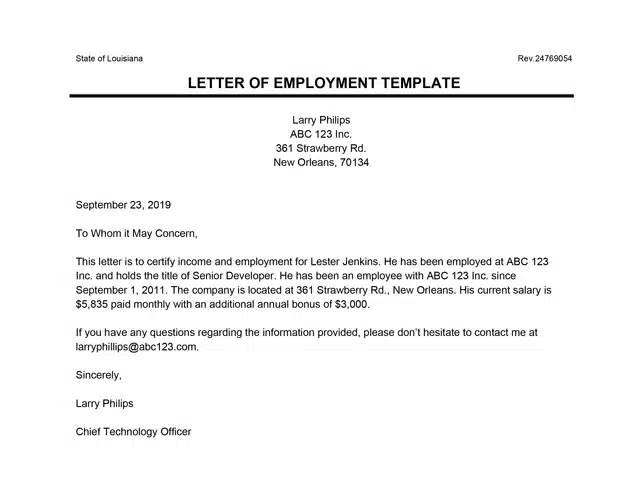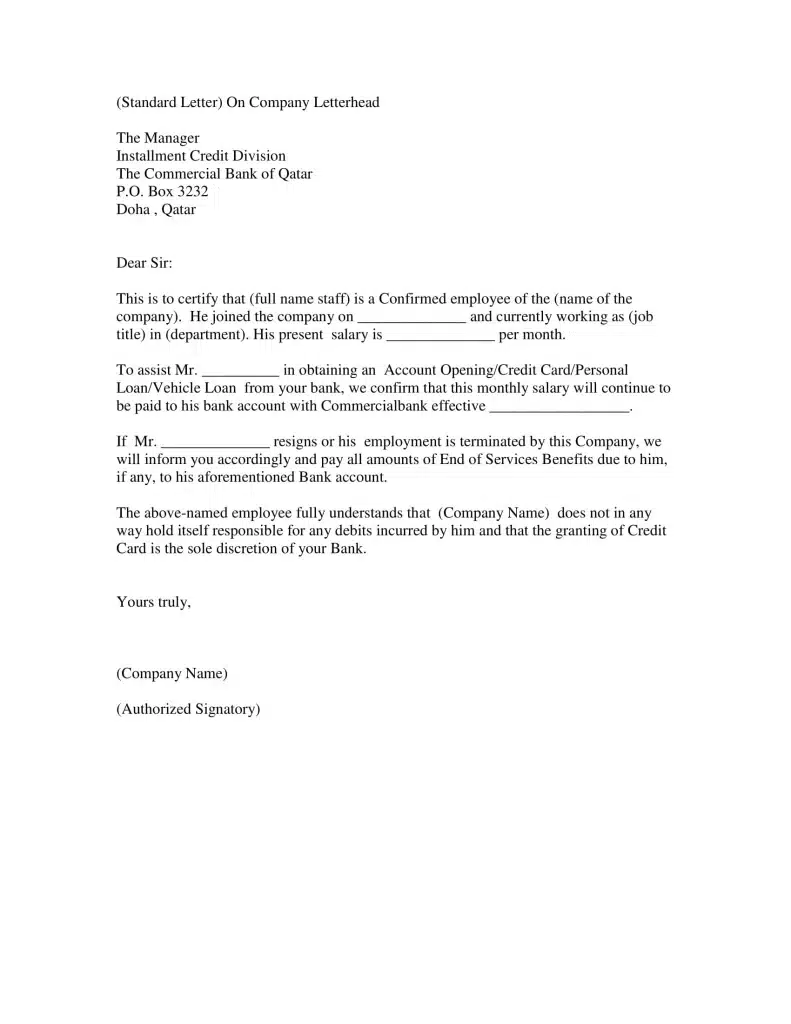Are you seeking to learn how to write an employment letter for verification? You could require the verification of your employment letter for a number of reasons, including immigration, and a mortgage. Employees attempting to rent or buy a property may require these letters from landlords or banking institutions. They may also be necessary for insurance purposes or to verify that a person actually worked for a company between the dates listed on a resume or job application. So whatever the reason, it is fully covered in this article, and there is an example of verification of employment letter that can guide you while writing.
Verification of Employment Letter
A “verification of employment letter” is documentation issued by current and previous employers to prospective tenants, job seekers, and others who need to demonstrate where they work or have worked, as well as occasionally how much money they make.
For the benefit of a new or potential employer, a current or former employee may ask for employment verification to vouch for their compensation and job history.
In order to confirm that a person has the income to cover monthly payments for a sizeable expense, whether, for a rental application, mortgage, or loan, a third party frequently requests an employment verification form.
For your information, a letter confirming employment is also known as:
- Income Verification Letter
- Proof of Employment Letter
- Work Verification Letter
- Employment Confirmation Letter
- Salary Verification Letter
Verifying parties often include their name, job title, contact information, current date, and proof of income or employment in a business letter format.
Who Needs an Employment Letter?
- If the rent reaches a specific level, the landlord could ask for an employment letter before renting an apartment.
- For mortgage applications, the majority of financial institutions and mortgage lenders also demand employment verification.
- A new employer could ask for employment verification to make sure the worker told the truth about their previous position and pay.
- In addition, a new employer could ask for employment verification to make sure the worker told the truth about their previous position and pay.
- If you are looking for a job at one of the numerous state or federal government agencies. You might also be required to acquire an employment verification letter from a previous or present employer.
- Before beginning a relationship with you, a lot of people, companies, and organizations want to know about your previous career history, income information, and employment status.
- It’s important to keep in mind that certain businesses and organizations want a signed release or authorization form before sharing any details about a current or former employee.
Verification of Employment Letter Example
An example of verification of employment letter will assist you when writing. These are some of the details you will see in the template.
- Name and location of the employer’s company: This confirms the area of your employment.
- The company’s name and address, along with an explanation of why you need a verification letter.
- The job title of the current or previous employee: Confirms that you are doing the duties you have described to the person making the request.
- The dates the current or previous employee was employed: Assures that the employment information available is up to date and accurate.
- A summary of the employee’s duties is optional, but it might help potential employers assess your current position’s requirements in light of your experience and management skills.
- The income of the current or past employee, including any incentives: Aids lenders in determining your capacity to make payments. It also aids employers in setting a competitive wage. Again, this method is prohibited in several areas; so, before disclosing this information, please check your local laws.
- Name, signature, and contact details: Enables recipients to get in touch with you if necessary.


How To Write Verification of Employment Letter
Follow the instructions below to learn how to easily write a letter of employment verification using a visual template. You can use this format if you need to compose this letter quickly or if you want easy-to-follow guidance for your message.
#1. Enter the Employer Information
An employer who confirms employment. Mention the employer’s name (or business) in the employment verification. Include the address as well.
#2. Provide the Requesting Party’s Information
Party Making an Employment Request. This is the entity, like a bank or a landlord, that is asking for proof of employment. Give the name and address of the requester. Leave this blank if you are unsure who made the request.
Contact Individual: Name the point of contact for the party asking for verification. Use “To Whom it May Concern” as your salutation if you’re not sure who made the request.
#3. Complete the Verification Information
- Employer’s Name: Enter the name of the person whose employment the employer is confirming.
- Workplace Information: The firm name, job title, employment start date, and company address are all included in the information about employment in this section.
- Information about pay and bonuses: This section lists the employee’s pay and any bonuses they may have received. The employer is permitted to attach further materials to this letter (keep in mind that there are state and local laws regarding salary disclosure and some require employee authorization).
#4. List the Employer’s Details
Describe your employer in full: name, title, contact details, and email address for the employer are listed here. It’s not required to include a title, phone number, or email address.
#5. Obtain Notary Acknowledgement
Acknowledgement from a notary public: The portion requesting an acknowledgment from a notary public is optional.
Steps to Follow When Writing your Verification of Employment
Make sure your letter adheres to the proper structure and offers the right information if you need to create an employment verification letter for someone.
#1. Observe Formal Letter Format.
When composing your letter, follow the regulations for business letters. Include the date, the recipient’s contact information, and your contact information at the top. Make sure to start with a salutation and end it with a handwritten signature.
Keep it brief. Letters confirming employment shouldn’t be very long. Don’t add anything to what the employee has already asked for. Don’t, for instance, give the employee’s work an evaluation.
#2. Include all of the Necessary Data.
The majority of employment verification letters include the recipient’s name, their department within the business and the duration of their employment. Ask your employee if you need to input any extra information. For instance, some letters mention the recipient’s pay, frequency of payment (weekly, bi-weekly, etc.), and the number of hours worked each week. However, unless specifically requested, omit these additional facts.
Offer to respond to any more queries at the letter’s conclusion. Give the receiver a way to get in touch with you, like your phone number or email address.
#3. Proofread and Edit it Before Sending.
Because it might have an impact on their home, future work, or insurance, this letter is probably crucial to your employee or former employee. Make sure to give this letter as much professionalism as you can. Before sending the letter, make sure it is error-free.
Verification of Employment Letter For Immigration
An employment verification letter for immigration is a letter intended to validate an expatriate’s position inside an organization. When an ex-pat requests a residency and work visa in the nation, the Immigration Service typically requires the letter. An employment verification letter for immigration serves as evidence that the person has actually worked for a company in the nation.
In essence, it contains a number of details, such as the expatriate’s name, the company they worked for, their start and end dates, their income information, their job title, and their position, among other important details.
Letters confirming employment attest to your or your sponsor’s eligibility for specific immigration benefits. These letters are frequently necessary for obtaining family-based green cards, employment-based green cards, work visas, B-1 temporary business visas, and B-2 tourist visas.
What You Should Include in an Employment Verification Letter for Immigration?
You can go above and beyond as an expatriate by making a list of the details the letter needs to include.
To begin with, the correspondence needs to be written on business letterhead. If you’re self-employed, you should type it on your company’s letterhead and provide your contact details. You must include the following details in the letter which are of the utmost importance:
- Salutation that is, such as “To whom it may concern” or “Dear [Name of agency]”
your job title. - The date of the employment contract ( starting and finishing date).
- Location of the business and useful contact information.
- Your yearly paycheck details.
- What day was the letter written? (whether by a company or self). Keep in mind that the letter should have been drafted just before the application’s filing date.
- Occupational classification (part-time, full-time, contract, temporary and more)
- An overview of the duties you will be performing during your job
- A signature line that contains pertinent information, such as the name of the company, the name of the employee, and the writer’s formal position within the company.
Keep in mind that the organization in question must have space for you and have already met the quota for expatriates.
Without it, the company would be unable to hire more foreign nationals than are permitted by regulatory organizations, which would result in a rejection.
Verification of Employment Letter For Mortgage
Lenders will require you to provide proof of several elements of your financial profile when you apply for a mortgage. An employment letter is among the most important documents you should present to your lender.
A letter of employment, also known as a job letter or an income verification letter, serves as proof of your employment status, identifies the nature of your work, and assists lenders in determining if you will be able to repay your mortgage.
How to Obtain a Verification of Employment Letter for a Mortgage
Employers are aware of the requirement for a letter of employment, thus the majority of them already have one on file and available for use. The Human Resources division of a large corporation will be able to assist you. You can approach your manager or supervisor if you work for a smaller business.
Although obtaining a letter of employment is not very difficult, you shouldn’t wait until the last minute. Though they do have an expiration date with lenders, you also don’t want to have it too soon.
Although the time frame varies per lender, in general, you want your letter of employment to be no older than 60 days to make sure the information is up to date.
How to Obtain a Verification of Employment Letter for a Mortgage as a Self-employed Person
Self-employed people may have more difficulty being accepted for a mortgage. You’ll have to rely on other documents since no one will be able to give you a letter of employment.
Those who are self-employed usually have to provide the following information to their mortgage lender:
- The last two to three years’ worth of income tax returns (be aware that showing a loss in revenue will work against you).
- A Notice of Assessment from the Canada Revenue Agency attesting that you have paid all of your taxes on time and that none are still owing.
- Evidence of the payment of HST and/or GST.
- Evidence that your company is a corporation or has a license.
- Financial records for your company detailing earnings, revenues, and costs.
- Contracts that, if appropriate, detail future revenue expectations (being able to show consistent income is a big plus).
- Evidence of your ownership stake in the company.
- Statements from personal and commercial banking accounts over the last six to twelve months, showing earnings.
How Do I Provide Verification of Employment?
You can easily provide your verification of employment by writing a letter and submitting it to your HR for signing. It’s important to give your company a template that has space for all the details that you would require them to fill. An employer’s letter confirming employment, which includes the employee’s dates of employment, job title, and income, is the most typical form of confirmation of employment.
What Can be Used as Proof of Employment?
Paystubs, tax returns, a letter from the employer that has been signed, or even a job offer letter might serve as proof of employment. Proof of employment is exactly what it sounds like: it demonstrates that a specific business employs you, that you have a specific position, and that you receive a specific salary.
No one is exempt from the demand for proof of work, regardless of the type of job or position they hold. You’ll need to provide evidence of your income, whether you have a regular salary job, an hourly wage, or you work for yourself.
Can I Write my Own Letter of Employment?
Yes, however, you’ll need to either obtain an HR or management representative to sign the letter or acquire their consent to disclose their identity, position, and details so the requestor may get in touch with them if necessary.
What Is a Full Verification of Employment?
A job candidate’s employment history is verified by an employer or a designated third party, such as a background check business. While employing someone, it’s crucial to take their past employment experience into account when evaluating their performance.
Unfortunately, embellishing or fabricating prior jobs is rather frequent. As a result, companies regularly include employment verification in their background check procedures.
Does the Employment Verification Letter Need to be Signed?
Any letter confirming employment must be signed by the employer, who must also include their full name and official title. It should typically be written no later than three months before the immigration application it is meant to assist.
Why Do People Need Employment Verification?
It is to make sure that a candidate’s credentials are valid and that they possess the expertise and skills they claim to have by checking the employee’s employment history. Verifying prior employment can reduce the danger of hiring someone with phoney credentials or an erroneous work history.
What Should an Employment Verification Letter Contain?
The letter is normally fairly simple and includes the following
- Employee’s name
- Current job title
- Employment dates
- Place of employment
- Whether they are still actively employed
- Current pay rate
- Frequency of payments.
In conclusion
The good news is that employment verification letters are typically straightforward paperwork that is easy to produce or get. Looking through sample letters and templates will help you get started if you need to make a request or compose a letter.
FAQs
Why is an employment letter required to get a mortgage?
Mortgages frequently include huge sums of money that must be repaid over a long period of time.
Whether it’s a bank or another financial organization, the mortgage lender must have faith in your ability to make timely mortgage payments or else they may decide to reject your application.
Evidence of employment demonstrates to the lender that you have a dependable job and the consistent income required to make mortgage payments. A letter of employment is an essential piece of the paperwork you will require, even though it is only one of several.
How long is employment verification letter valid for?
The letter of job verification is regarded as being valid for 4 weeks after it is issued. Although the US embassy has no specific guidelines for authenticity, it is typically acceptable if it was prepared and signed within the last 4-6 weeks.
Who calls to verify employment?
Government agencies, mortgage lenders, potential employers, collection agents, and other parties may ask an employer for proof of employment (VOE) on a current or former employee.






